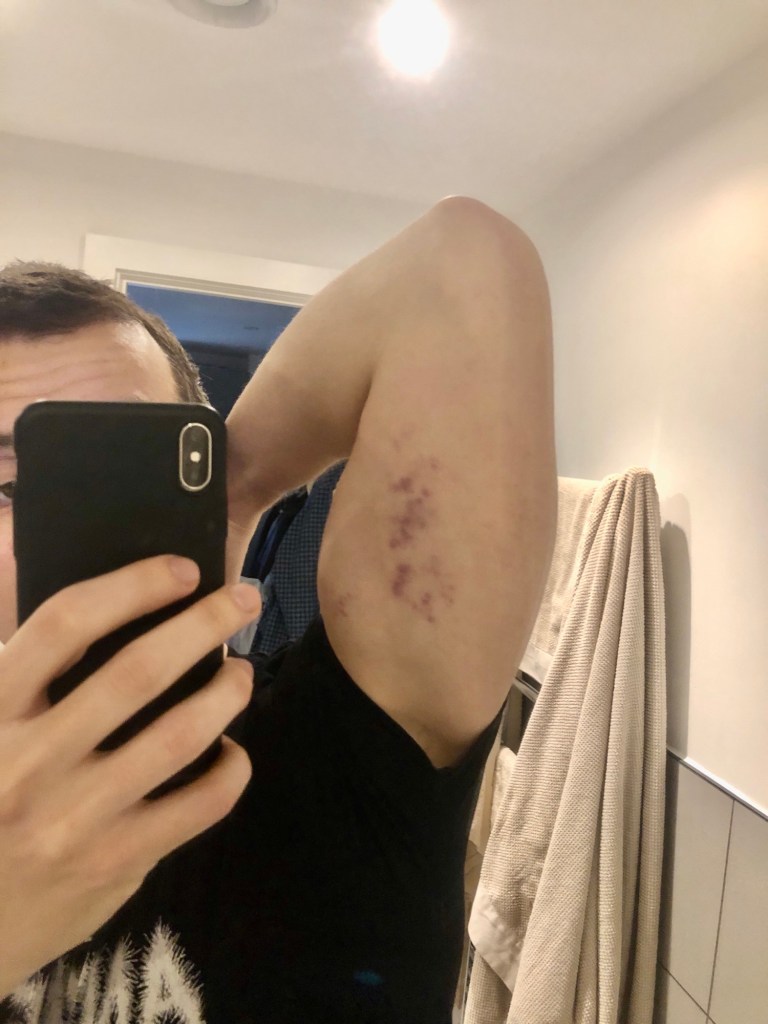28th September 2023, White Belt Diaries V
Over the summer my second stripe comes shortly after my first. I beam with pride over the two little strips of fabric on my belt and I bore my girlfriend with boasts of how I feel like I’m naturally well-suited to the discipline of BJJ. Finally, the years of playing board games and time spent in the gym are paying off (well, for something other than ruining relationships with my uncompromising dominance at Catan and regretable thirst traps I posted during the pandemic). I’m moving up the line in class towards where the more senior white belts are situated. Heck, even the instructor knows my name now and I’m no longer mistaken for the Greek guy in my class.

Altogether, I feel like I’m gaining confidence, I feel like I’m beginning to understand some of the principles at work. I feel like I get the better of classmates in the specifics most of the time. I’m getting submissions and advancing positions more easily. I’m competing with some of the guys who started before me, and I flatter myself that my classmates think I’m half-decent. The BJJ-ego is growing.
Soon after my second stripe, I earn my third. ‘I must be preternaturally good at this sport’, I catch myself thinking, ‘I’m the next Gisele’ (a little call back there for the handful of those actually reading these blogs – enjoy.)
Pride cometh before the fall.

Once you get the third stripe, you get access to the senior classes, aka GB2. GB2 is for everyone three-stripe white belt and up. It’s where the more advanced techniques are taught, and the class for everyone from blue to black belt. It also allows you to attend the ‘study halls’ (open classes where you can ask for techniques to be taught) and actual sparring (beyond the minimal stuff we do in classes).
I soon realise, the third stripe is the equivalent of a provisional license. It’s only the start of you getting on the road that is the sport. It is, as I come to call it, the ‘You’re Not A Bonehead’* card.
I quickly deem the reason that you have to wait for three stripes is because i) you need to know the basics before you can move onto more advanced techniques (obviously) ii) they need to know you’re competent enough to not die in GB2 (risk management for you) but also iii) they need to know that you’re not going to go crazy and try to (deliberately or not) injure a long-standing member of the club (risk management for them). Beyond that, it’s not much of a measure of your skill.
So far, I’ve only sporadically encountered higher belts. Sometimes they will attend the beginner class. But even when you roll with them, you can tell there is a ‘going easy’ that is generally occuring. They will make encouraging noises, they will allow you to practise the technique, they may offer some resistance but it’s always somewhat half-hearted.
GB2 is a step up in a way that I hadn’t imagined. I go from thinking myself the 30-something prodigy to being wiped the floor with. Black belts barely hide their contempt when rolling with you, and if they do, they rarely use you as more than a warm-up. Purple belts roll you up like a pretzel. Blue belts, so often the whipping boy for higher belts in the class, use the newly promoted three-stripes as a chance to unleash their skills – if they sense any competitiveness from a white belt, they mercilessly punish them for the audacity of challenging a higher belt. It’s a tough few weeks to begin with.
Gone are the boasts when I come back home, replaced with terse responses when asked how class was – ‘Yeah, fine’ or ‘Tough night’. There is little need to ask – the friction burns on the neck, the bruises on the arms, the limp I’m walking with, the bust-up lips – are all clear enough signs that I have gone from the hammer to nail in jiu jitsu.



It’s a remarkably healthy check on the growing ego. Even though I manage to begin to develop a defence from being completely steam-rolled, even as I start to learn more, it is a punishing process. I see some of the guys I started with attending less and less until they disappear completely.
You may have good nights where you pull something off, where you are pleased with yourself, where you begin to convince yourself that you’ve gotten over the hump, but these delusions are easily balanced by nights where you get beaten a dozen times in a row.
You start to understand the meaning of ‘win or learn’, and understand very frequently. I ‘learn’ a lot. The lessons are bitter pills. You develop a thick skin and learn to be the nail. Once you get caught in some submission or other, you fist bump the higher belt and go again. And again. And again. And again. You begin to ask questions of what you did wrong, how you improve, and the higher belts will graciously explain why. After all, if you learn not to get caught by some move or other, it makes you a better training partner for them, and makes them better in turn. Embracing humility is the only way you begin to become the hammer, and not the nail, again.
It is incredibly humbling and becomes one of the more valuable lessons of the sport – to balance ones responses to victory and defeat as much as possible. As the cliche goes, it’s a rollercoaster of emotions. BJJ teaches you a concentrated dose of managing your response to the emotions. And this helps to tune out some of the indiginities and annoyances of normal life – someone cut me off? Someone did something annoying at work? Someone said something rage-inducing on Twitter? So what? Last night I got physically dominated to the point where someone was choking me until I tapped in submission. It’s an indiginity most people won’t have suffered since being a child and getting beaten up by an older sibling or bully. Most of the indiginaties you face in modern life are pedestrian by comparison.
BJJ is a true test of your emotional maturity to be able to deal with that kind of physical defeat – and you’re tested a lot.
*I may have used a different word.